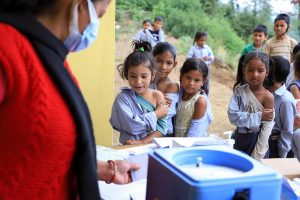
The launch of vaccinations for this age group was enabled by the 2.2 million pediatric vaccines donated to Nepal by the US Government through the COVAX Facility.
Since the beginning of the COVID-19 pandemic and the development of novel COVID-19 vaccines in a relatively short space of time, there has been an increasingly negative perception of vaccines. This has been fuelled by disinformation on social media platforms, as well as distrust in governments and pharmaceutical companies and political figures. The country of Nepal stands in stark contrast to this trend. Nepal has relatively high COVID-19 vaccine rates, at 68%. Nepal’s adoption of all vaccines, including the COVID-19 vaccine (which is now also being distributed to 5–11-year-olds at the request of parents who do not want their children’s education further disrupted by COVID-19) has moved beyond mere acceptance to active demand for vaccines from the population. Photo- Laxmi Prasad Ngakhusi, UNICEF
Berlin, 18 October 2022 – A new UN report shows that women’s and children’s health has suffered globally, as the impacts of conflict, the COVID-19 pandemic, and climate change converge with devastating effects on prospects for children, young people, and women.
Data presented in the report show a critical regression across virtually every major measure of childhood well-being, and many key indicators of the Sustainable Development Goals (SDGs). Since the last, Every Woman Every Child Progress Report published in 2020, food insecurity, hunger, child marriage, risks from intimate partner violence, and adolescent depression and anxiety have all increased.
An estimated 25 million children were un or under-vaccinated in 2021 – 6 million more than in 2019 – increasing their risk of contracting deadly and debilitating diseases. Millions of children missed out on school during the pandemic, many for more than a year, while approximately 80% of children in 104 countries and territories experienced learning loss because of school closures. Since the start of the global pandemic, 10.5 million children lost a parent or caregiver to COVID-19.
“At the core of our unkept promise is the failure to address the gaping inequities at the root of global crises, from the COVID-19 pandemic to conflicts and the climate emergency. The report describes the impacts of these crises on women, children, and adolescents, from maternal mortality to education losses to severe malnutrition,” said Antonio Guterres, United Nations Secretary-General.
The report provides wide-ranging evidence that children and adolescents face wildly divergent chances of leading a healthy life simply based on where they are born, their exposure to conflict, and the economic circumstances of their families. For example:
· A child born in a low-income country has an average life expectancy at birth of around 63 years, compared to 80 in a high-income country. This devastating 17-year survival gap has changed little over recent years. In 2020, 5 million children died even before the age of 5, mostly from preventable or treatable causes. Meanwhile, most maternal, child and adolescent deaths and stillbirths are concentrated in just two regions – sub-Saharan Africa and South Asia.
· More than 45 million children had acute malnutrition in 2020, a life-threatening condition that leaves them vulnerable to death, developmental delays, and disease. Nearly three-quarters of these children live in lower-middle-income countries. A staggering 149 million children were stunted in 2020. Africa is the only region where the number of children affected by stunting increased over the past 20 years, from 54.4 million in 2000 to 61.4 million in 2020.
· The six countries with the highest numbers of internally displaced persons – Afghanistan, the Democratic Republic of the Congo, Ethiopia, Sudan, the Syrian Arab Republic, and Yemen – are also among the top 10 food insecure countries.
· A woman in sub-Saharan Africa has around a 130 times higher risk of dying from causes relating to pregnancy or childbirth than a woman in Europe or North America. Coverage of antenatal care, skilled birth attendance, and postnatal care are far from reaching all women in low- and middle-income countries, leaving them at elevated risk of death and disability.
· Millions of children and their families are experiencing poor physical and mental health from recent humanitarian disasters in Afghanistan, Ethiopia, Pakistan, Somalia, Ukraine, and Yemen. In 2021, a record 89.3 million people worldwide were driven from their homes by war, violence, persecution, and human rights abuse.
The report calls upon the global community to address this damaging trajectory and protect the promises made to women, children, and adolescents in the Sustainable Development Goals. In particular, it advocates for countries to continue investing in health services, address all crises and food insecurity, and empower women and young people around the world.
The report, titled Protect the Promise, is published by global partners, including WHO, UNICEF, UNFPA, Partnership for Maternal, Newborn & Child Health (PMNCH), and Countdown to 2030, as a bi-annual summary of progress in response to the UN Secretary General’s Every Woman Every Child Global Strategy for Women, Children’s and Adolescents’ Health. The most comprehensive synthesis of evidence on the current state of maternal, newborn, child, and adolescent health, it updates the last Every Woman Every Child Global Strategy Progress Report published in 2020.



